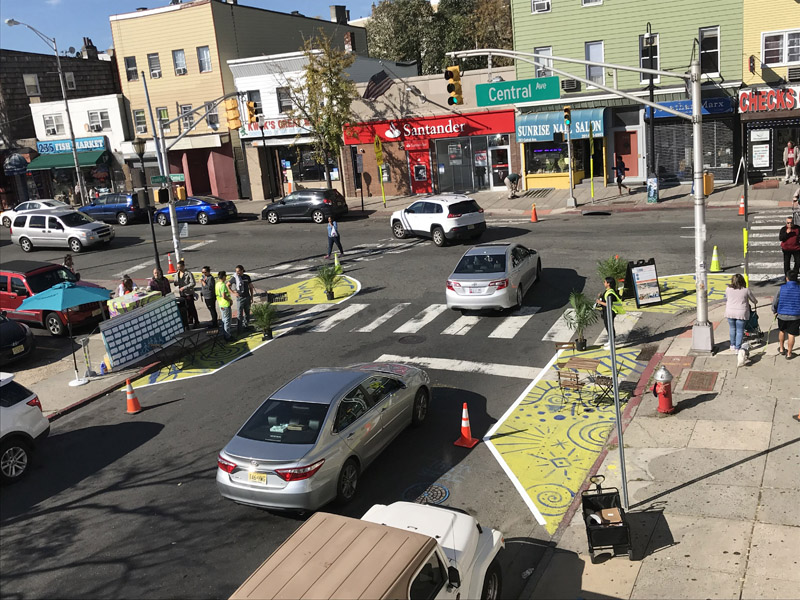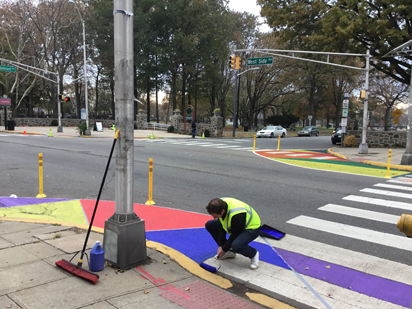
City of Jersey City
The City of Jersey City used temporary paint to show residents what safety improvements could look like at six intersections.
Bright colorful triangles jutted out into the road, hugging the curbs at the intersection of Westside Avenue and Belmont Road in front of the entrance to Lincoln Park in Jersey City, New Jersey last November.
The colorful geometric design wasn’t an art installation—though many would describe it and five similar projects across the city as works of art. The painted pavement was used to demonstrate what the intersection could look like if the curbs were extended to make it safer for people to cross.
Plants and temporary plastic posts, called delineators, were used to prevent motorists from cutting the corners and driving across the painted area while turning. A giant poster filled with blank thought bubbles encouraged passersby to share their views on the temporary changes.
The demonstrations were a innovative way to gather public input for the JC Walks Pedestrian Enhancement Plan study, which was funded through the North Jersey Transportation Planning Authority’s Subregional Studies Program. There were walkability workshops at each of the six locations to allow people to audit the surrounding area and identify concerns—like cracked sidewalks—and discuss potential improvements. The city also had staff explain the project to people just passing by and encourage them to leave feedback. All of this supplemented traditional public meetings.

City of Jersey City
The City of Jersey City used temporary paint to show residents what safety
improvements could look like at six intersections.Barkha Patel, a senior transportation planner for Jersey City, said when the project began some residents said such changes would never work, but the demonstrations showed what was possible and helped the city generate support. People liked them so much that they asked the city to leave the temporary paint in place.
“It was important to get people on board, and I think that is what this helped us do,” Patel said.
And the projects were also beneficial to the city’s staff.
“It made people comfortable with the idea that we can test things on our streets, and we can use it as a lab,” she said. “It’s not a static thing.”
The project was so successful that Jersey City will be turning to demonstrations again, this time to install temporary bike lanes as part of its Bike Master Plan effort.
“Our general approach with anything that we’re doing from now on is we want to be testing things as the study is going on and adjusting accordingly so that the final product is a lot more advanced than it could have been if we didn’t test anything at all,” Patel said.
Her advice for anyone else looking to implement a demonstration project is to be flexible—due to rain they had to use colorful duct tape instead of paint at one location—and to not be afraid to make changes if the first attempt isn’t a complete success. She also encourages towns to think longer term if things go really well.
“There are a lot of pros to temporary projects because they can make people comfortable and you can basically pop them in and take them away but don’t be so invested in temporary projects that you let go of opportunities for more permanent ones, if you have that go after them as well,” she said.
Jersey City has already put more permanent paint in place at the six demonstration intersections and six others where the study recommended improvements. Local schools and artists helped decorate them.
“As we get funding for those projects we’ll make sure that it is actual concrete curb extensions, but for now we wanted to get in whatever we could,” she said.
Melissa Hayes is managing editor of InTransition magazine.